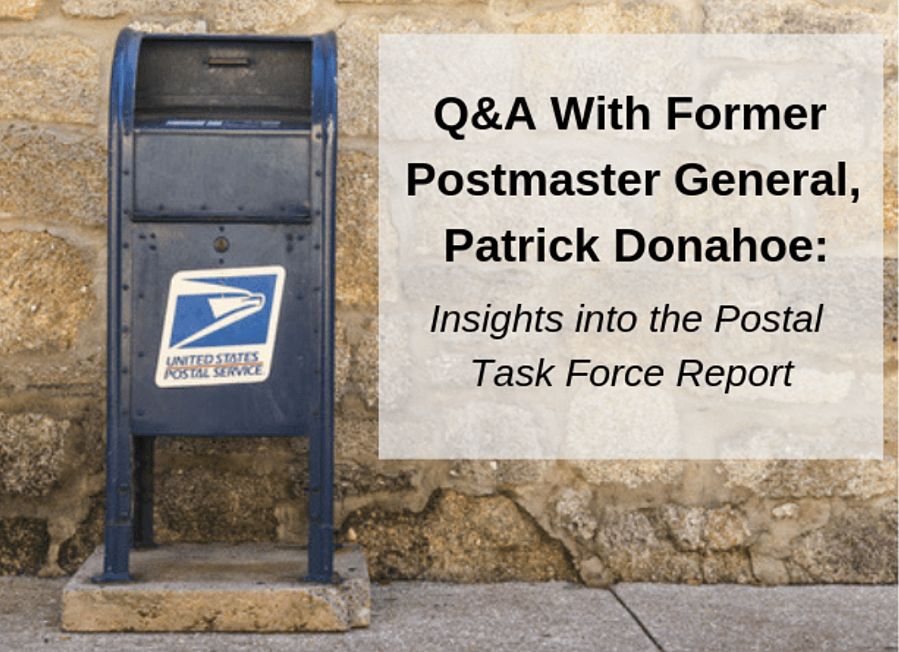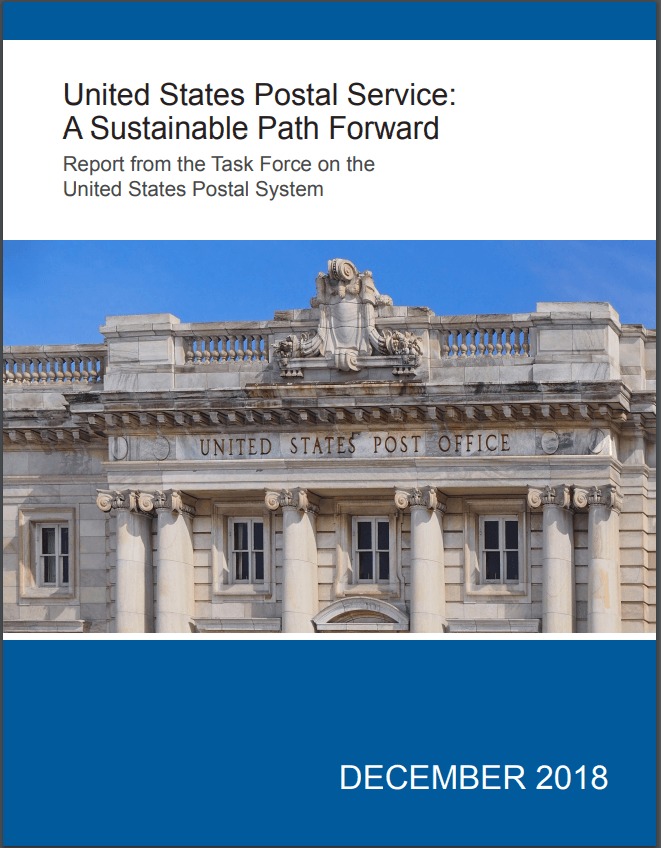RESOURCES
BLOG
Join in the community forum! The thINK blog is a place for community members to share their opinions, best practices, successes, and challenges. Add your comments to the blogs published here or write a blog and we’ll post it for you.

Q&A with Former Postmaster General, Patrick Donahoe: Insights Into the Postal Task Force Report
We recently sat down with former Postmaster General and current SG360° board member, Patrick Donahoe, to get his thoughts on the U.S. Department of Treasury’s recently released task force report United States Postal System: A Sustainable Path Forward.

Q. As the former Postmaster General, what are your overall thoughts regarding the Task Force’s report?
A. The fact that a Task Force was appointed by the President is a very positive move. It potentially signals to Congress that the Executive Branch is interested in pursuing legislation to address many of the problems the Postal Service faces. Most of the issues identified by the Task Force can only be resolved via legislation. There are a few actions that can be addressed through administrative means, but a long-term fix requires legislation.
The other positive point that can be derived from the Task Force activity is the recognition of the value of the Postal Service, both as an economic and social force in the United States. Our US Postal Service is second to none in the world and serves at the hub of an equally important mailing and shipping industry. The value stream generated by the industry is a powerful force in the economy and the postal network is critical for continued growth in the e-commerce market.
Q. What in particular stood out to you?
A. Several issues stood out in the Task Force report. I think the discussion around universal service was interesting. From a postal point of view, we always looked at universal service in terms of universal service at a universal price. Even though there is a substantial cost to maintaining the universal service network, I always felt, and still do today, that it is the defining strategic advantage that the Postal Service possesses. The ability to reach everyone in the country with a defined, time sensitive network cannot be replicated by anyone within a reasonable cost. The Task Force opens the discussion around a product-centric universal service definition. I think this approach warrants further examination and could help define which products remain in the market dominant realm versus competitive. I think retaining the network requirements are critically important.
I was disappointed that the retiree health benefits (RHB) issue was not discussed in more detail. Referring to it as a taxpayer issue does not address the issue with the importance that it requires. Any legislative decision requires that RHB be resolved in order to address both balance sheet and income statement problems for both the short and long term. It should have been discussed in more depth by the Task Force.
Finally, I was disappointed in the discussion of revoking collective bargaining rights by the unions. The unions stepped up and helped to address long term labor costs when the Postal Service faced serious financial difficulties in the 2010-11 time frame. This issue would also be a nonstarter in legislative discussions.
Q. Regarding the recommendation to give the USPS the authority to charge market-based prices for mail not deemed "essential services," sustainable pricing could compound the problem of declining mail volume as marketers reduce or eliminate their usage of direct mail. How do you get above this?
A. I think that as an industry we should use the opportunity presented by the Task Force and take a fresh look at the pricing process for Marketing Mail and commercial First-Class Mail. The CPI cap pricing regime has been a major problem for the Postal Service. In a world of volume growth, price caps are not preferred, but they are doable. In a world of volume loss of 30%+, they are untenable. The CPI price caps combined with RHB prefunding requirements have ruined the Postal Service's financials despite remarkable efforts to reduce costs across the enterprise. This has to change.
I think it is a good time to take a completely fresh look at the process. The Postal Regulatory Commission has yet to complete their required ten-year pricing review. Why not take advantage of the timing? Take a two-pronged approach. Resolve short term pricing to provide some relief on the cap and start the process for a long-term pricing solution. We have come quite far in the last few years with the Intelligent Mail Barcode in terms of visibility, tracking, digital linking, etc. Why not focus on using this type of information to create a value-based pricing method versus the cost base process that we have employed for years. Contract pricing could be set by the customer or by the mail service provider with the goal being a win-win price and spend for both the mailing customer and the Postal Service. There are many combinations of price, volume, digital click-through, purchase activities, etc. that could be used to establish new pricing schemes that could result in solid financials for all while improving the value of the mail in the mailbox.
There are plenty of smart people in the industry. They should be able to figure it out.

Q. What is the tipping point of cost versus value for the direct marketer?
A. I’m not sure that we should look at the investment into mail strictly in terms of a tipping point on price. Sure, you can spend a lot less on digital advertising campaigns, but everyone knows that the open and act rates are much lower than what is found with mail. The key is value. What stands out in the mailbox? How is mail targeted in an effective way? What is the ROI on the campaign? In this digital world, mail still has the best open and read rate, along with the best ROI.
One of the things that impresses me about SG360° is the quality and eye appeal of the mail pieces that we produce. The ability to provide customers with programs that tie digital and physical mail as part of the customer outreach is critical. That’s where the value that customer is seeking is realized. Price is important, but value is key. Conveying that to mailing customers is of utmost importance to this entire industry.
Q. What do you see as the impact - both positive and negative - of franchising the mailbox? What could these impacts have on direct mail marketers?
A. That was an interesting suggestion. I think that on the package side of the ledger, the Postal Service would be able to structure a process to implement a franchising model for mailboxes. They could do it by customer such as FedEx, UPS, Amazon, etc. It could also be done by zip code or by segments of a zip code. The Postal Service has the ability to manage many iterations of this idea. The big question is, however, would anyone want to do it? That remains to be seen.
Regarding direct marketers, I don’t see a lot of value unless they’d want to set up their own delivery routes. That is extremely expensive. Even if you only served a geographic area once a week. With the labor market as tight as it is, securing a reliable workforce to perform this type of work would be extremely hard and expensive. Keep using the Postal Service!
The Postal Service franchises retail work today with contract postal units and Village Post Offices, so there is a place in the market for that type of activity.
Q. Is the USPS mandated to follow through on the recommendations? If no, do you think they will?
A. I think that the Postal Service will follow through on the recommendations that they can do on their own. The key to that happening is, however, the placement of a full board of postal governors. There are only two governors on the board as we speak and both face term expirations. The jobs need to be filled now.
The Postal Service can undertake the work to more clearly define universal service, if they choose to update it. They can also work on pricing and product placement recommendations to the PRC as outlined by the Task Force, if they choose to do that also. We moved a number of products from market dominant to competitive while I served as the Postmaster General. Recommendations made by the Task Force in these areas would require a thorough vetting and discussion with all stakeholders.
Q. Most of the recommendations require a lot of discovery or due diligence in order to make additional recommendations or define the path forward. What are your thoughts on this?
A. Very little that was recommended by Task Force was completely new. There has been work done at one point on almost all the recommendations. On issues that the Postal Service would choose to address, management and the governors would have to do the legwork necessary and put the plans into action.
Most of the recommendations, however, require legislation to be implemented. This is a lot harder than one would think. On almost every one of these recommendations, stakeholders, to some degree, hold positions on opposite poles. Getting everyone to yes is tough. Believe me, I’ve had plenty of experience in this space and on every occasion, I came up empty handed. There must be movement on all sides to reach a successful conclusion to postal legislation. A financially troubled Postal Service is problematic for both the industry, the employees, the economy and the American public.
Q. What recommendation(s) do you see as the easiest to implement?
A. The easiest recommendation would be to take some action on the pricing issues that were raised. The PRC is working through the ten-year review and could, as part of the Task Force follow up, implement price changes based on work and commentary that has already taken place. They could change the price cap regime to include revenue makeup rates such as CPI+2 or 3 over several years. There would be a lot of push back and could even end up in legislative proposals. It’s not as easy as it sounds.
Bottom line, the best solution would be to use the Task Force report to spur comprehensive legislation, including RHB resolution, and address all issues that will affect the Postal Service and the industry in the long term. Along with that, have the PRC complete the ten-year review, update the pricing rules in the short term and look for win-win pricing solutions for the long term.
The full task force report is available from the United States Department of Treasury.
For more content like this, visit blog.sg360.com.
thINK member Jeana Garms is Director of Marketing at SG360°. A seasoned marketer experienced in designing and executing omnichannel marketing campaigns that combine the spectrum of marketing channels to drive desired actions and achieve results.
